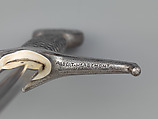Academician Sword and Scabbard of Fernand Sabatté (1874–1940)
Auguste Albert Herbemont French
Manufacturer Coulaux et Compagnie Klingenthal, France
Not on view
Complete with its scabbard, and in excellent condition, this sword occupies a notable place among the examples created for members of the Institut de France’s learned academies, as one of the earliest that were explicitly designed in reference to, and as a homage of, the life and accomplishments of their recipients, and to break away from the hitherto conservative design of academician swords, which through World War I seem to have generally been modeled after military and civil-servant swords. Designed in the art deco style, it also is one of only a handful of academician swords in the form of medieval knightly swords.
Designed by the sculptor and medalist Auguste Albert Herbemont (1874–1953), it was created for presentation to Jérôme Guillaume Fernand Sabatté (1874–1940), a painter of architectural and religious subjects, portraitist, and sculptor. A pupil of Gustave Moreau (1826–1898), Sabatté won the Grand prix de Rome in 1900 for his picture, "Un Spartiate et l'Ilote," now in the collections of the École nationale supérieure des Beaux-Arts de Paris, and taught painting at École des Beaux-Arts of Lille from 1926, and at the École des Beaux-Arts of Paris after 1929, the year he founded the Journal L’Art.
The sword was presented to him in relation to his election to the Académie des Beaux-Arts of the Institut de France on June 20, 1935 (section peinture, fauteuil 5). Martial in appearance, decorated on the pommel with a Stoic motto ("endure and refrain", from the Enchiridion, or Handbook, which provides a summary of the teachings of the philosopher Epictetus), and adorned on the grip with the gilded figure of the saint patroness of the city of Paris, the sword was evidently designed to appeal to Sabatté, a World War I veteran who had contributed to the protection and preservation of monuments and works of art during the conflict, a painter fascinated by the interiors of medieval churches, and a leading figure in the life of the École des Beaux-Arts of Paris until his death.
Signed on the hilt with the name of the artist, decorated on both the pommel and blade with inscriptions commemorating the circumstances for its creation and presentation, identifying the individual for whom it was made, and executed with great care and skill, this sword is a remarkable and early example of a class of unique and imaginative allegorical weapons designed for artists and intellectuals, which are still being made today for the new members of France’s distinguished academies.
Due to rights restrictions, this image cannot be enlarged, viewed at full screen, or downloaded.
This artwork is meant to be viewed from right to left. Scroll left to view more.





